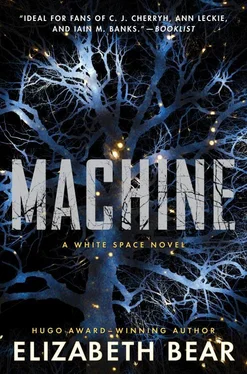Now we only had to get Sally talking to it, assuming there was anything in there to talk to. Or controlling its electronics, if it was just a drone.
I had magnetized some specialized equipment to the outside of my hardsuit in areas that would be out of my way until I reached for them. Here in the shadow of the hospital and the cargo doors, my suit’s heater took its turn to complain. Still better than being inside, with Afar’s gelid atmosphere leaching all the warmth out of me.
I peeled a set of induction patches off my hardsuit and applied each of them separately to the craboid’s chassis, scrambling around it to get them as close to opposite one another as possible. The drones had withdrawn to a safe distance: Linden was paying attention, then. I followed suit, climbing down to the edge of the cargo hold and using one door for cover.
“Clear,” I told Sally.
“Active,” she replied. “I’ll see if I can use the patches to access the thing’s processors.”
“It might have some.”
“Ugh,” she said, cheerfully. “I get enough of that from Hhayazh. Signal is getting through the patches, so that’s circumventing at least some of the shielding. If I can’t just talk to it, then I should be able to use electromagnetism to move it by brute force— Oh, hey, I already have an electronic handshake.”
“What does that mean?”
“It means it acknowledges my contact. And, now that I’m past the shielding—that is an intense level of shielding, by the way!—it’s easy to talk to.”
“That was a little too easy.” I frowned.
“Standard Synarche protocols. At least I’m not going to have to write the code for this one.”
So it wasn’t some kind of weird alien spaceship parasite. It was just a surface vehicle with a super unsettling design.
Sure, that was a fine explanation.
“You don’t suppose this is some kind of exploratory vehicle, do you? Designed for ox breathers on a cold methane world?”
“Survey equipment?” She hrm ed. “That would explain all the legs. Designed for any kind of terrain, and manipulating its environment, and even a bit of earthmoving, hmm?”
“Hmm,” I agreed.
“Okay, are you ready to bring it around to the machine bay?”
_____
The craboid followed me out the open cargo doors, across Afar’s hull, and (using its own maneuvering jets) across the gap to Core General with no incident. Under Sally’s puppetry, it stumped along behind me like a weird pet, or like some sort of limpet monster from a poorly produced horror three-vee.
It did not, however, pry the hospital apart, or punch through the hull with a needlelike proboscis, or behave in any sort of an uncivilized manner at all. It walked behind me, climbing courteously through the machine bay airlock when Sally directed it to, then settling down on the deck and resting quietly there while we set up the isolation zone.
“Can you convince it to give us an atmosphere sample?” I asked Sally.
“There’s no airlock, and I can’t get the pressure door to respond,” she answered. “That appears to require some sort of manual override failsafe code which I can’t quite crack. There’s no AI in here: it’s just a machine.”
“A vehicle, not a person.” Disappointment has a metallic tang.
“Vehicles can be persons, as you know perfectly well,” Sally replied tartly.
I supposed it was better to imagine the craboid empty and waiting than to picture it as home to a lonely and terrified presence that might be in there peeking between their appendages in bewilderment, presuming they had both peekers and appendages to peek through.
“There must be some way to open it from the outside,” I said. “Otherwise you’d go EVA in a hostile environment and come back to discover you’d locked your keys inside.
“And then you’d die.”
“Yes, but whatever the code is I do not have it. It might be a DNA lock, for all I know. So it’s brute force all the way around,” Sally answered. “Want to have a go at it?”
The machine bay had a me-compatible atmosphere, but I didn’t bother deactivating out of my hardsuit, because I wasn’t through with it yet. While drones pitched a containment bubble around the craboid, I fetched a sampling drill from an equipment locker. The drill was too massy to stick to my turtle shell. It’d be in the way, and I didn’t want to carry it around.
By the time I was armed, I had to come back toward the craboid via the airlock built into the bubble. I made sure the interior flap was secured shut behind me before Linden pumped her own ox atmosphere out and pumped a nonreactive nitrogen atmosphere in.
I rigged the drill, set up a brace to hold it in position, and stepped back before triggering.
The bit was diamond grown around a nanotube lattice for tensile strength. It whined against the hatch, a sound that scraped through my magnetic soles and my eardrums to vibrate along my bones and make my back teeth ache. It would have been even worse inside the craboid, so it was just as well there were no passengers.
The idea was that I would drill a very small hole in the craboid, enabling me to get a sample of the atmosphere inside. Then we’d have a better idea of who might use such a thing.
I was a little concerned that the craboid might be programmed to take evasive or defensive measures. But it stood there and waited quietly while I worked to pry its carapace open.
Right up until the drill bit snapped.
A piece of bit ricocheted off the deck plates and the craboid while I, reflexively, cowered. I got lucky: it pinged off my hardsuit, then lodged in the flexible collar of the nitrogen bubble’s lock. No hiss of commingling or escaping atmosphere followed.
Sally was immediately in my senso, asking if I was all right.
“Fine,” I said. I touched my faceplate. The drill bit had taken a tiny, glittering chip out of it right in the most distracting possible spot, but it wasn’t cracked or cracking, and it hadn’t gone through and taken out my eye. So that was lucky, and the hardsuit would heal itself quickly. “The drill bit broke. That’s not supposed to happen. Even if the diamond shattered, the nanotubes should hold it together.”
I pulled the bit out of the collar material and examined the broken end. Under magnification, I could see that the nanotubes were sheared off a little above the surface of the bit. The stub, still gripped in the drill chock, showed the same damage. It looked like the tubes had been stretched slightly. The ends looked slightly deformed, as if they had been pulled apart rather than cleanly cut.
“That’s definitely not supposed to do that.” I hooked Sally into my senso feed and got Hhayazh with her. I let them use my eyes to inspect the damage. “It looks like something weakened the structure of the tubes.”
“Vibrations?” Hhayazh asked.
“Harmonics, you mean?” I frowned through the chipped faceplate. “Maybe? Well, nobody died. I don’t know how we’re going to sample that atmosphere, though.”
“Sally’s density readings give it a pretty standard oxygen saturation.”
“A little rare for my tastes, but yes,” I admitted. “Figuring out what the atmosphere is made of from how fast sound waves go through it is not as certain as actually getting your hands on a little bit of air and running a few tests, however.”
Hhayazh made one of its noises, the kind that might mean exasperation or might mean amusement. “Well, we could get out a laser torch—”
“I don’t want to be in the neighborhood if a cutting beam starts ricocheting around!”
“Fine, just wait for it to open up on its own. That seems likely.”
“Don’t get your ovipositor in a twist, Hhayazh.”
Читать дальше












